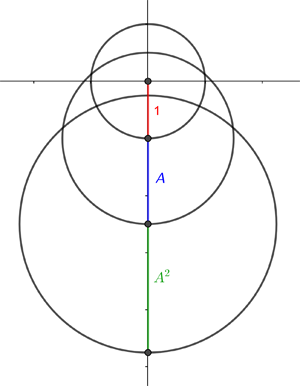We are looking at an infinite family of circles. The first circle is centred on the point  and has radius
and has radius  . Every other circle is centred on the South pole of the previous circle and has radius
. Every other circle is centred on the South pole of the previous circle and has radius  times that of the previous circle. (In the first example in the main article we have
times that of the previous circle. (In the first example in the main article we have  , but we give a sketch of the proof for general
, but we give a sketch of the proof for general  .)
.)

The family of circles with the two lines of intersection. The y-intercept is the silver ratio.
We want to show that all the intersection points that lie on the same side of the  -axis lie on a straight line, as shown in the diagram above.
-axis lie on a straight line, as shown in the diagram above.
We will also show that the two lines of intersection meet the  -axis in the point
-axis in the point  If
If  we have
we have
![\[ \frac{1}{A-1}=\frac{1}{\lambda _ n-n}=\lambda _ n, \]](/MI/a3ab85f71b3290d5476ec27ff105999d/images/img-0004.png) |
as claimed in the main article.
First notice that the radius of the  circle is
circle is  . This is because the first circle has radius
. This is because the first circle has radius  and any other circle has radius
and any other circle has radius  times the radius of the previous circle.
times the radius of the previous circle.
Also notice that for  the
the  circle has centre
circle has centre  That’s because the centre of the first circle is
That’s because the centre of the first circle is  and the
and the  -coordinate of the centre of any other circle is the
-coordinate of the centre of any other circle is the  -coordinate of the centre of the previous circle minus the radius of the previous circle. (The first circle has centre
-coordinate of the centre of the previous circle minus the radius of the previous circle. (The first circle has centre  .)
.)

The centres and radii of the first three circles.
Our proof rests on the fact that there is quite a simple transformation of the plane which sends each circle in the family to the next one along. This transformation, call it  , consists of a scaling by a factor of
, consists of a scaling by a factor of  , followed by a translation by 1 in the direction of the negative
, followed by a translation by 1 in the direction of the negative  -axis. In other words,
-axis. In other words,  sends a point with coordinates
sends a point with coordinates  to the point with coordinates
to the point with coordinates 
We leave the following two facts for you to prove:
- The transformation
 sends a circle with centre
sends a circle with centre  and radius
and radius  to circle with centre
to circle with centre  and radius
and radius 
- The transformation
 sends a straight line with equation
sends a straight line with equation  to the straight line with equation
to the straight line with equation  .
.
By point (1), the  circle in our family gets sent by
circle in our family gets sent by  to a circle with radius
to a circle with radius  and centre
and centre
![\[ (0,-A(1+A+A^2...+A^{n-2})-1)=(0,-(1+A+A^2...+A^{n-1})). \]](/MI/5a5d7028038caaa501ac563b7bd8494f/images/img-0004.png) |
And that’s exactly the  circle in our family, as required.
circle in our family, as required.
To show that the intersection points of circles lie on a straight line as claimed, let’s first think about the line segment  which connects the intersection points
which connects the intersection points  and
and  as shown below.
as shown below.

Points of intersection and the line segments connecting them.
By point (2) above,  sends
sends  to another straight line segment (rather than some curvy shape). Because
to another straight line segment (rather than some curvy shape). Because  sends each circle to the next one along, that line segment, call it
sends each circle to the next one along, that line segment, call it  is the one connecting the intersection points
is the one connecting the intersection points  and
and  Point (2) also says that
Point (2) also says that  and
and  have the same slope — and from this it follows that
have the same slope — and from this it follows that  ,
,  and
and  all lie on a straight line. You can apply the same argument to other line segments connecting consecutive intersection points, to show that all intersection points lie on the same straight line, call it
all lie on a straight line. You can apply the same argument to other line segments connecting consecutive intersection points, to show that all intersection points lie on the same straight line, call it  .
.
The argument above also shows that  sends
sends  to itself. This implies that
to itself. This implies that
![\[ Ab-1=b. \]](/MI/f5bc87bc38e6498db7d8d872fb5189ee/images/img-0009.png) |
Rearranging gives
![\[ b=1/(A-1), \]](/MI/f5bc87bc38e6498db7d8d872fb5189ee/images/img-0010.png) |
as required.
Back to the main article.